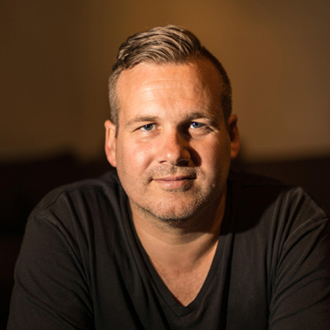Jonas Jeberg Co-Writes & Co-Produces Big Hit “High Hopes” For Panic! At The Disco, Plus Other Hit Songs

Pop songwriter & producer Jonas Jeberg, who is originally from Denmark and is now based in Los Angeles, is enjoying his biggest hit to date. He co-wrote & co-produced the major hit single, “High Hopes,” by rock band Panic! at the Disco. This joyful, high-energy song has had multi-format success in the U.S., becoming a Top 5 hit on the Billboard Hot 100, plus reaching #1 on Billboard’s Hot Rock Songs, Alternative Songs and Adult Pop Songs charts.
“High Hopes” has also become a hit in many other countries, and has been certified platinum or gold in the United Kingdom, Canada, Germany, Australia, Switzerland, Austria, Norway and New Zealand.
In addition to “High Hopes,” Jeberg has co-written a wide range of hit songs during the past decade. In 2008, he co-wrote the hits “I Hate This Part” for the Pussycat Dolls and “One Step At A Time” for Jordin Sparks. Then after moving to Los Angeles in 2012, he co-wrote the hits “Marry Me” by Jason Derulo (in 2013), “Sledgehammer” by Fifth Harmony (2014), and “Fetish” by Selena Gomez feat. Gucci Mane (2017).
Jeberg’s expertise is in composing the music, writing melodies, playing keyboards, creating the tracks and producing. He’s also had cuts with Demi Lovato, Bebe Rexha, Nicki Minaj, Daya, Kylie Minogue, Vanessa Hudgens, The Wanted, Pixie Lott, Kelly Rowland, Kreayshawn, Jessie J, Hayley Kiyoko and Kodaline.
Jeberg is represented by Lucas Keller of Milk & Honey Management and Jack Ormandy of SILO Music.
We are pleased to do this new Q&A interview with Jonas Jeberg. He tells how he got started as a musician in Denmark, and how he co-wrote some of his early hits. He also tells the fascinating story of how “High Hopes” was written and became a hit for Panic! at the Disco.
DK: How did you get started as a musician and songwriter in Denmark?
Jonas Jeberg: Well, I grew up in Denmark, and when I was 12, I went to this school where there was a gospel choir. The leader of the choir knew that I could play drums, so he asked me to drum for the choir. That was my introduction to being a musician, and I would practice drums eight hours a day. Then when I was 18, I was a professional drummer touring around Scandinavia.
Around that time, I applied to the Academy of Music in Denmark. To get in, you have to learn music theory and play a second instrument like piano or guitar. So I learned to play piano, and through that, it inspired me to start writing songs.
DK: How did you start getting cuts as a songwriter in Denmark?
Here’s the video of Panic! at the Disco’s hit “High Hopes,” which
was co-written by Jonas Jeberg.
Jeberg: After being at the Academy of Music for two years, I decided I wanted to find an artist that I could make a full demo with, and try to get a deal with. So I met this female artist that I did 16 songs with. Her manager shopped the songs, and Warner/Eternal Records said they loved my productions, but they didn’t want to sign the artist. So they asked me to produce a couple of their other projects, and that was my start.
Then I signed to a company called Murlyn Music in Sweden that was co-owned by hit songwriter & producer, Anders Bagge (who’s worked with Britney Spears, Janet Jackson and many artists). Anders heard and liked my songs, so he called me up and asked if I wanted to write with him. We then worked on cuts with Jessica Simpson and Mya. I also traveled to Los Angeles for the first time in 2004, and a Norwegian artist I worked with got signed to Columbia Records in the U.S. I also came home with cuts with other U.S. artists.
DK: You also worked with Cutfather, a hit Danish writer/producer. How did you connect with him?
Jeberg: Around that time, Cutfather had heard of my success in the U.S., and he asked me if I wanted to team up. So in 2005 I teamed up with Cutfather, and we had a nice run. A lot of cuts started to happen, and we had the hit “One Step At A Time” with Jordin Sparks and “I Hate This Part” for the Pussycat Dolls. Then in 2010, I left the Cutfather team and I went on my own, and I started going a lot more to the U.S. to write and produce. Two years later (in 2012), I decided it was time to make the move to Los Angeles, and build a studio there.
DK: I like your hit song for the Pussycat Dolls, “I Hate This Part.” How did you co-write this song and place it with them?
Jeberg: “I Hate This Part” came from a session with Wayne Hector, Lucas Secon and Cutfather. Wayne is really good at coming up with hook lines, and he kept singing the melody line that became the hook of “I Hate This Part.” Then I [created] new chords from that melody, and started playing it as a piano theme and made it into a progression, where the top notes were in that melody. And that became the link through the whole song, and from there, the song just took an hour to finish. I remember that the four of us were sitting, playing the song in the car and driving Wayne and Lucas back to the hotel.
That night, we sent the song to Ron Fair (A&R exec) at Geffen Records, and when we came in the next morning, there was an email from Ron saying, “When can you come to L.A. to record this? I want this song for the Pussycat Dolls.” So that was really quick.
Here’s the video of Selena Gomez’s hit “Fetish” feat. Gucci Mane, which
was co-written by Jonas Jeberg.
DK: A year ago, you co-wrote the hit “Fetish” with Selena Gomez & Gucci Mane. How did you get together with Selena and Gucci Mane on this song?
Jeberg: Originally, the song started with four of us—Brett McLaughlin, Gino Barletta, Chloe Angelides and me. We sat down to write a song, and halfway through the session, it felt like a Selena Gomez song to us. So we were like, “Let’s really aim this for Selena.” At some point while we were working on the demo, Brett said, “I know this producer team, the Futuristics, who are working closely with Selena on this project.” So he gave me their number, and I called up Alex (Schwartz) from the Futuristics. We had a talk, and then from there, they made some changes (co-writing the song) and we finished the production. Then we played it for (label exec) Aaron Bay-Schuck, who was then A&R exec for Selena at Interscope Records. He loved the song, and he played it for Selena, who loved it too. It took a while before she went into the studio and recorded it, but when she did, she absolutely killed it. It definitely felt like the right match.
DK: As a songwriter & producer, what are your strengths? Is it writing melodies and creating the tracks?
Jeberg: I like to go in the studio and write from scratch…so I’m the guy at the piano, and with maybe a little (chord) progression going. And then we start writing the song from there. That’s my initial role in it, then I come up with a lot of melodies.
DK: Do you also write some of the lyrics?
Jeberg: I would say that I don’t come up with a lot of lyrics, but I like to criticize it (laughs). One thing that maybe helps is that I’m Scandinavian, and English is not my first language. So sometimes it’s good if we can [keep the lyrics a bit more simple] for the rest of the world to understand. And I think I can help with that sometimes (laughs).
DK: Congratulations on having a big hit with “High Hopes” by Panic! at the Disco. Can you talk about how this song came together? I recently did an interview with one of your co-writers Tayla Parx, and she said it was written at a BMI writing camp.
Jeberg: Yes that’s right. There were about 25 writers who were invited to a BMI writing camp in Aspen, Colorado. This was in 2015. Four of us—me, Tayla, Ilsey Juber & Cooks Classic—arrived there about an hour early. This was my first time at the Aspen camp; the others had been there before. And the others were saying, “We always go to this hot tub outside.” So the four of us jumped into this hot tub. And for some reason within five minutes, we started writing the hook for “High Hopes.” I was sitting in the hot tub, singing bass notes…we didn’t have any instruments because we were in the hot tub (laughs). I was singing bass notes and directing chords in that way, and we were brainstorming different lyrics. Within 20 minutes, we had the whole hook. So we jumped out of the hot tub and I quickly put up a little portable studio in one of the rooms in the house we were at, and [recorded] those horns that’s kind of the signature of the song. And the four of us made that hook demo really quick. At first, we thought it was a rap hook, so we were like, “Oh, we’re done…we don’t need to do anymore” (laughs).
Here’s the video of the Pussycat Dolls’ hit “I Hate This Part,” which
was one of the first hits that Jonas Jeberg co-wrote.
(After the writing camp), we started pitching it around to artists, but everyone passed on it. Then in 2016, we got an email from (music execs) Evan Taubenfield and Jonathan Daniel at Crush Management, who said, “We’ve heard this hook—we absolutely love it. Panic (at the Disco) is not in the album cycle at the moment, but we’re serious about this. We think it could be a big hit for Panic.”
A good amount of time passed, and then I got an email that said, “Okay, we’re ready to move forward with this. We’re starting to get into the studio and work on things.” From there, they finished the song. A lot of it was done by Brendon Urie (lead singer & songwriter of Panic! at the Disco) and his producer, Jake Sinclair, and some people they brought in to write the verses. Then at the end of it, they sent me back the song, and they asked me to co-produce it with Jake Sinclair.
DK: So how does it feel to have co-written & produced such a big hit?
Jeberg: It’s an amazing feeling to have a hit that’s done well on three formats—number one at Top 40, Hot AC and Alternative at the same time. Being number one on the radio has been my dream since I started this, and to get there is such a relief and such a great feeling.
- Pop/Soul Singer/Songwriter RuthAnne, Who Has Written Several Hits, Talks About Her Excellent New Solo Album, The Moment - September 9, 2025
- Caitlin Mae’s “House Sitting” Named September “Best Song Of The Month” - September 8, 2025
- Rising Artist Bebe Stockwell Talks About Her Excellent EP, Driving Backwards, Her Song “Minor Inconveniences,” And Her Songwriting - August 27, 2025


